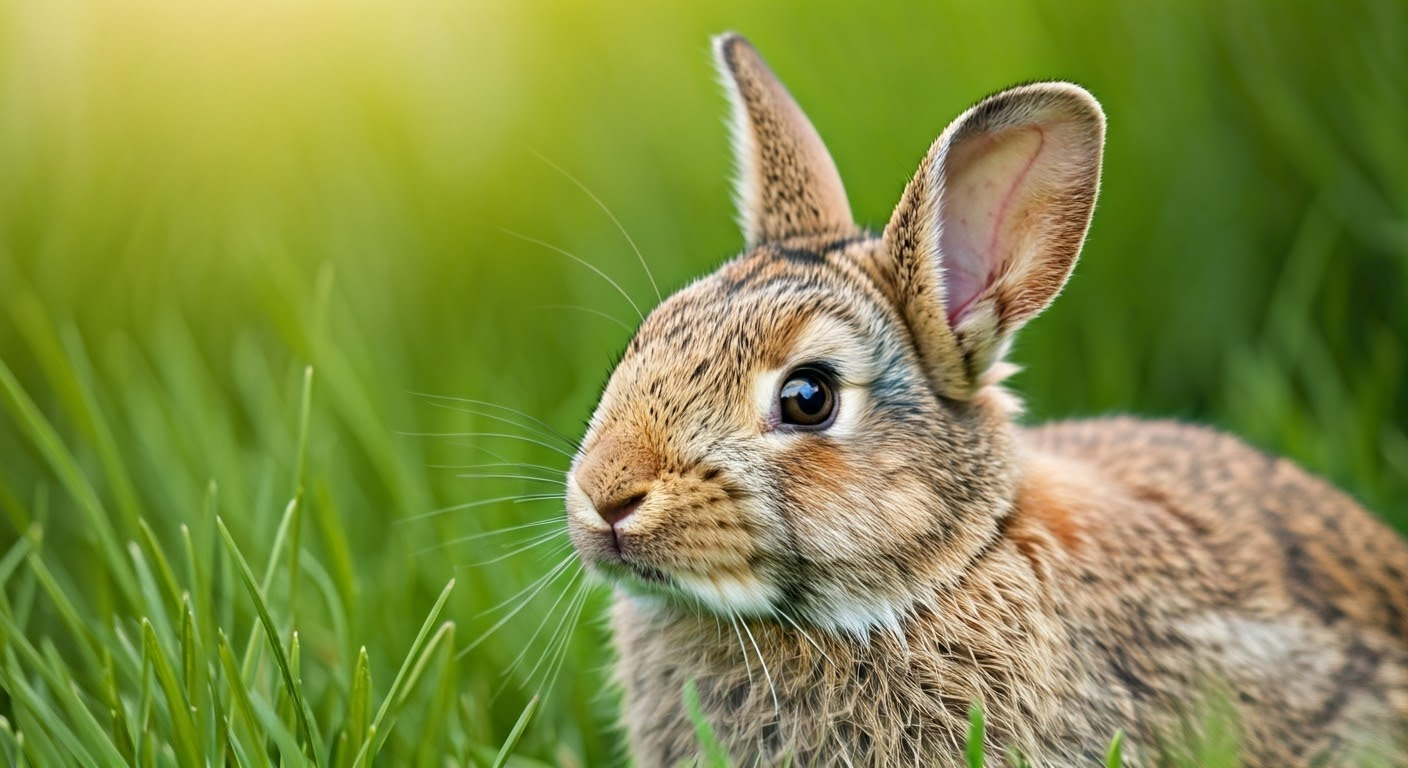What are the symptoms of rabbits infected with Raillietina?
Rabbits with Raillietina can lose weight. They might also eat less and be less active. These rabbits often drink more water too. In serious cases, they can have diarrhea and stomach pain. You may even notice bits of tapeworm in their poop. It is very important to take your rabbit to the vet regularly. Getting them dewormed helps keep them healthy.

Key Highlights
- Raillietina is a type of tapeworm that mainly infects rabbits.
- These parasites live in the intestines and can lead to health problems.
- They often spread when rabbits eat infected intermediate hosts, such as beetles.
- Symptoms of infection include weight loss, diarrhea, and stomach pain.
- A fecal exam is commonly needed to find Raillietina eggs for diagnosis.
- A veterinarian usually provides antiparasitic medicine for treatment.
Introduction
Raillietina is a type of tapeworm that can harm rabbits. To protect your rabbits, you need to learn how this parasite lives and spreads. Rabbits often get infected when they eat animals with Raillietina larvae. This blog post will explain how Raillietina affects rabbits, how to spot it, and how to treat and prevent these infections.
Overview of Raillietina in Rabbits

Raillietina infections are often found in places like North America, Central America, and Africa. These parasites mainly target the intestines of rabbits. The issues they create can range from mild to very serious, based on the severity of the infection.
Rabbits can catch Raillietina by eating sick insects. Beetles and ants often carry this disease. It’s important to look for signs of infection. If you notice anything unusual, take your rabbit to a vet right away. This is very important for the health of rabbits that have Raillietina.
What is Raillietina?
Raillietina is a kind of tapeworm. It can also infect marsupials. This worm is a parasite that lives in the intestines of rabbits. Raillietina has several segments in its body. These segments help it attach to the lining of the intestine. Each segment can hold eggs. If there are too many eggs, they can cause an obstruction in the intestine. This lets the worm breed inside the rabbit’s intestines.
When Raillietina, a type of tapeworm, goes into a rabbit’s intestine, it sticks to the wall. It has special parts that help it hold on. This lets the worm take in nutrients and grow larger. As the tapeworm grows, it breaks off parts that contain eggs. These parts exit the rabbit in its poop. This way, the parasite keeps its lifecycle going.
Knowing how Raillietina worms work is important. This helps us see how they can harm a rabbit’s digestion. It’s essential to notice the signs of infection early. If we can do this, we can make sure to treat the problem quickly and effectively.
The Life Cycle of Raillietina Parasites
The Raillietina parasites rely on indirect transmission to live. They require other animals, like cockroaches or annelids, as hosts for bustards to grow. Beetles and oribatoid mites usually serve as these hosts. They eat Raillietina eggs found in their environment. Later, when animals consume these beetles, they can get infections in their bile ducts.
Inside the beetle, the eggs turn into larva. These larva grow and make cysts inside the beetle’s body. When a rabbit eats a beetle that is infected, the cysts break apart in its stomach. This causes young tapeworms to be released.
The young tapeworms live in the rabbit’s intestine, where they share this space with other animals, such as cotton rats, which may harbor larvae in their skeletal muscle. This starts their life cycle again. It can also include larvae of Trichinella spiralis. The link between the parasite, the second intermediate hosts, and the final host is very important. By managing the environment, we can help stop Raillietina infections.
Impact of Raillietina Infection in Rabbits
The effects of a Raillietina infection in rabbits can change a lot. This difference depends on how many worms are present, the rabbit’s health, and if there are other infections too. Sometimes, rabbits can have this parasite without showing any signs of illness.
Other times, Raillietina infections can lead to several health issues. They may harm a rabbit’s digestion and overall health. It is very important to find and treat the infection quickly. This can help stop serious health problems in the future.
Clinical Signs of Raillietina Infestation
The signs of a Raillietina infection in rabbits can vary. If the infection is mild, the rabbits may just lose a little bit of weight or eat less food. However, as the infection becomes worse, they may show more serious signs.
One clear sign a rabbit is not well is diarrhea. Sometimes, you may notice mucus or blood mixed in. A rabbit suffering from a serious infection might feel abdominal pain. You can often tell by watching them sit hunched over and refuse to move.
Having tapeworms in the gut can cause rabbits to miss out on important nutrients. This can lead to weight loss and weakness. It’s important to look for these signs and consider a Raillietina infection. If you notice these issues, a vet can quickly provide the right help.
Long-term Health Implications for Infected Rabbits
If Raillietina infections are not treated, they can be bad for rabbits’ health. The parasites live in the intestine and cause ongoing inflammation. This makes it difficult for the intestine to function properly.
In serious cases, Raillietina can block the intestine. This is a big problem that needs fast care from a vet. When the intestine is unhealthy because of these parasites, rabbits can catch other infections more easily. This can hurt their health.
It is important to visit the vet regularly. If your rabbit has a Raillietina infection, treat it right away. This can help prevent serious health problems in the future. Taking good care of rabbits is the best way to help them live long and healthy lives.
Diagnosis and Detection of Raillietina

Diagnosing Raillietina infections involves a thorough physical exam and some lab tests. Veterinarians begin by reviewing the rabbit’s medical history. They look for any signs of illness and focus on any stomach problems.
To check for Raillietina, fecal tests look for tapeworm eggs. In the lab, they use methods like fecal flotation and sedimentation. These techniques help to separate and find the Raillietina eggs.
Laboratory Techniques for Identifying Raillietina
Laboratories test feces to check for Raillietina infections and other trematodes and nematodes. Veterinarians use special tests to find tapeworm eggs. These tests help confirm the diagnosis of infections and assess the potential attachment of parasites.
One common way to find Raillietina eggs is by using a method called fecal flotation. In this method, you mix a sample of stools with a special liquid. This liquid makes the eggs float to the top. Scientists can then look at this floating layer using a microscope.
Another way is fecal sedimentation. Here, the fecal sample mixes with water. The heavier bits, like the eggs, sink down. We also look at this sediment under a microscope.
|
Technique |
Description |
|
Fecal Flotation |
A fecal sample is mixed with a solution that causes the eggs to float to the surface for microscopic examination. |
|
Fecal Sedimentation |
A fecal sample is mixed with water, allowing heavier particles, including eggs, to settle at the bottom for microscopic examination. |
These lab methods help find Raillietina eggs. They look at the size, shape, and other important details. This makes it easier to obtain the correct diagnosis.
Role of Imaging in Detecting Parasitic Presence
Fecal tests are the best way to find Raillietina infections. Sometimes, imaging tests can help too. These tests show how far the infection has gone. They can also help doctors look for other reasons for the rabbit’s symptoms. Imaging provides important details about the rabbit’s digestive system.
X-rays can help look for any blockages in the intestines. This can occur in serious cases of Raillietina. Sometimes, doctors use an ultrasound to find problems or lesions in the intestines that might relate to the infection.
These imaging methods are not often used to diagnose Raillietina. Still, they can give more information. This extra detail helps vets make better decisions about treatment and care.
Treatment Options for Raillietina in Rabbits
To treat Raillietina infections in rabbits, you can use several methods. First, you need to remove the parasites. Second, it is important to reduce the symptoms. Lastly, you should prevent the infections from returning. A major part of the treatment is giving antiparasitic medicine.
A qualified vet will provide these drugs. They are effective against tapeworms. These drugs also break the worms’ cycle. This helps remove the worms from the rabbit’s body.
Pharmacological Treatments and Their Efficacy
Pharmacological treatments are the main way to handle Raillietina infections in rabbits. Antiparasitic drugs target tapeworms. These drugs work to get rid of the parasites in the rabbit’s body.
The success of these treatments can vary for each case. It depends on several factors. These include the type of drug used, the severity of the infection, and the rabbit’s overall health. A common medicine for this is Praziquantel. This drug is an antiparasitic. It works well against Raillietina.
These medicines stop the tapeworm from getting nutrients. They can also keep the tapeworm from moving. This causes the tapeworm to die and helps remove it from the rabbit’s body. The correct amount and treatment duration will depend on the veterinarian’s advice.
Alternative and Supportive Care Strategies
Supportive care is very important for treating Raillietina infections in rabbits. It works alongside medication. This care helps lessen the symptoms of the infection. It also helps keep the rabbit healthy as it heals.
A balanced diet with many nutrients is important for your rabbit. It helps keep their immune system strong and replaces any nutrients they lose. Fresh water is key as well. This is especially needed if your rabbit has diarrhea, to prevent dehydration.
Creating a clean and comfortable space for your rabbit can reduce its stress. A tidy area can help your rabbit feel better more quickly. Other treatments might help as well, but it’s very important to speak with a vet who understands rabbits before trying them.
Preventative Measures Against Raillietina Infection

Preventing Raillietina infections in rabbits is very important. It stops the life cycle of the parasite. This reduces the chances of rabbits getting infected. They can become infected by eating hosts that carry the parasite, especially beetles.
To avoid problems, we need to take care of the environment. Clean rabbit homes regularly. This helps cut down on places where beetles can live. A tidy living space is very important. Plus, by being proactive and visiting the vet often, we can lessen the chances of Raillietina infections.
Environmental Management to Reduce Risk
Effective environmental management is key to stopping Raillietina infections in rabbits. Rabbit owners can lower the risk of these parasites. They should remove places where the parasites might live. It is also important to limit rabbits’ contact with intermediate hosts.
It is important to keep your rabbit’s space clean. Clean and disinfect their hutches, cages, or living areas often. This helps remove any tapeworm eggs that might be present. Remember to take out the food and water bowls at night. Wash them properly before putting them back. Doing this can help lower the chance of contamination.
It is very important to keep wild animals away from rabbits. This includes rodents and some mammals. Wild animals can carry germs and parasites that make rabbits sick. You should check that rabbit enclosures are safe and secure. There should be no gaps for these animals to get in. This helps prevent direct contact between them.
Importance of Regular Veterinary Check-ups
Regular vet check-ups are important for finding and treating Raillietina infections in rabbits. When you take your rabbit to a trained vet, they will do a full health check. This helps to find and fix any health problems quickly.
During check-ups, vets can examine stool samples. This helps them find Raillietina eggs, even in rabbits that appear healthy. Finding the infection early can prevent it from getting worse and help avoid issues.
Regular vet check-ups are important for rabbits. They help vets look at the rabbit’s health. This way, they can find problems early before they get worse. A good relationship between rabbit owners and their vet helps ensure that pets receive the best care.
Case Studies and Research Findings
Case studies and research findings provide helpful details on how to treat and manage Raillietina infections in rabbits. Many studies check how well different antiparasitic drugs work. They also look into new methods to control these parasites.
The recorded cases show that treatments work well. They highlight how important it is to find the problem early. Using the right medicines and providing support is key to achieving good results. This research helps us learn more about Raillietina infections. It can also help us improve the health of rabbits.
Successful Treatment Regimens Documented
Many studies indicate that treatments for Raillietina infections in rabbits can work well. These studies usually use antiparasitic drugs such as praziquantel. They also offer other support to help the rabbits recover.
Good results happen when treatment begins right after diagnosis. It is important to tailor the treatment to what each rabbit needs. Success can rely on several factors. These factors include the seriousness of the infection, the rabbit’s health, and the treatment plan you choose.
These case studies provide useful information for vets. They help vets learn how to treat sick rabbits more effectively. They also show what recovery could look like. The knowledge from these studies helps improve rabbit healthcare.
Ongoing Research in Parasitology Related to Raillietina
Ongoing studies in parasitology are very important. They help us understand Raillietina spp. and other parasites that harm rabbits. These studies look at the chromosome number in these parasites. Scientists and researchers want to find new information. They pay attention to the lifecycle of these parasites, how they spread, and ways to control them better.
Current studies in India are trying to make better antiparasitic drugs. These drugs should have fewer side effects. The United States is providing support for this work. Researchers are also exploring new methods to check for and stop Raillietina infections. They are working to improve testing tools and to create vaccines to reach this aim.
The findings in parasitology are very useful for rabbit health. This is especially true for what we learn about swine, poultry, and crustaceans. These findings help vets and owners. They give them the knowledge and tools they need to stop and treat parasitic infections.
Conclusion
In conclusion, it is very important to know how Raillietina affects rabbits. You should recognize the signs of illness and how it can affect their health over time. Finding issues early with lab tests and scans can help a lot. There are treatments, like medicine and care options, that can manage the infection well. To lower the chance of a Raillietina infection, it is essential to keep their area clean and visit the vet regularly. By staying aware and taking steps, pet owners can keep their rabbits happy and healthy. If you have concerns about Raillietina in your rabbits, talk to a veterinarian for help and advice.
Frequently Asked Questions
Can Raillietina Infections in Rabbits Be Completely Cured?
Yes, if you check rabbits fast and care for them right, Raillietina infections can usually be cured completely. Sick rabbits can get better with good help from a vet.
How Can Pet Owners Prevent Their Rabbits from Getting Infected?
Pet owners can prevent Raillietina infections in their rabbits by keeping their homes clean. It is essential to clean these areas regularly. They should also ensure that rabbits do not interact with any animals that could act as intermediate hosts. Going to the vet often is important too. This helps find any problems early and get the correct treatment.

Hi, I’m Sondip,
I’m a writer who loves to help people solve their problems. I write about small animals like mice and other small animals and even pests.

